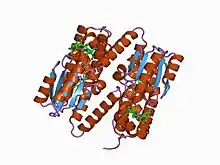Vitamin B12-binding domain
In molecular biology, the vitamin B12-binding domain is a protein domain which binds to cobalamin (vitamin B12). It can bind two different forms of the cobalamin cofactor, with cobalt bonded either to a methyl group (methylcobalamin) or to 5'-deoxyadenosine (adenosylcobalamin). Cobalamin-binding domains are mainly found in two families of enzymes present in animals and prokaryotes, which perform distinct kinds of reactions at the cobalt-carbon bond. Enzymes that require methylcobalamin carry out methyl transfer reactions. Enzymes that require adenosylcobalamin catalyse reactions in which the first step is the cleavage of adenosylcobalamin to form cob(II)alamin and the 5'-deoxyadenosyl radical, and thus act as radical generators. In both types of enzymes the B12-binding domain uses a histidine to bind the cobalt atom of cobalamin cofactors. This histidine is embedded in a DXHXXG sequence, the most conserved primary sequence motif of the domain.[1][2][3] Proteins containing the cobalamin-binding domain include:
- Animal and prokaryotic methionine synthase (EC 2.1.1.13), which catalyse the transfer of a methyl group from methyl-cobalamin to homocysteine, yielding enzyme-bound cob(I)alamin and methionine.
- Animal and prokaryotic methylmalonyl-CoA mutase (EC 5.4.99.2), which are involved in the degradation of several amino acids, odd-chain fatty acids and cholesterol via propionyl-CoA to the tricarboxylic acid cycle.
- Prokaryotic lysine 5,6-aminomutase (EC 5.4.3.4).
- Prokaryotic glutamate mutase (EC 5.4.99.1).[4]
- Prokaryotic methyleneglutarate mutase (EC 5.4.99.4).
- Prokaryotic isobutyryl-CoA mutase (EC 5.4.99.13).
| B12-binding | |||||||||
|---|---|---|---|---|---|---|---|---|---|
 nmr structure of glutamate mutase (b12-binding subunit) complexed with the vitamin b12 nucleotide | |||||||||
| Identifiers | |||||||||
| Symbol | B12-binding | ||||||||
| Pfam | PF02310 | ||||||||
| InterPro | IPR006158 | ||||||||
| SCOP2 | 1be1 / SCOPe / SUPFAM | ||||||||
| |||||||||
| B12-binding_2 (4-helical bundle cap domain) | |||||||||
|---|---|---|---|---|---|---|---|---|---|
 how a protein binds b12: a 3.o angstrom x-ray structure of the b12-binding domains of methionine synthase | |||||||||
| Identifiers | |||||||||
| Symbol | B12-binding_2 | ||||||||
| Pfam | PF02607 | ||||||||
| InterPro | IPR003759 | ||||||||
| SCOP2 | 1bmt / SCOPe / SUPFAM | ||||||||
| |||||||||
The core structure of the cobalamin-binding domain is characterised by a five-stranded alpha/beta (Rossmann) fold,[5] which consists of 5 parallel beta-sheets surrounded by 4-5 alpha helices in three layers (alpha/beta/alpha).[6] Upon binding cobalamin, important elements of the binding site appear to become structured, including an alpha-helix that forms on one side of the cleft accommodating the nucleotide 'tail' of the cofactor. In cobalamin, the cobalt atom can be either free (dmb-off) or bound to dimethylbenzimidazole (dmb-on) according to the pH. When bound to the cobalamin-binding domain, the dimethylbenzimidazole ligand is replaced by the active histidine (His-on) of the DXHXXG motif. The replacement of dimethylbenzimidazole by histidine allows switching between the catalytic and activation cycles.[7] In methionine synthase the cobalamin cofactor is sandwiched between the cobalamin-binding domain and an approximately 90 residues N-terminal domain forming a helical bundle comprising two pairs of antiparallel helices.[7] This N-terminal domain forms a 4-helical bundle cap, in the conversion to the active conformation of this enzyme, the 4-helical cap rotates to allow the cobalamin cofactor to bind the activation domain.[8]
References
- Krautler B (August 2005). "Vitamin B12: chemistry and biochemistry". Biochem. Soc. Trans. 33 (Pt 4): 806–10. doi:10.1042/BST0330806. PMID 16042603.
- Ludwig ML, Matthews RG (1997). "Structure-based perspectives on B12-dependent enzymes". Annu. Rev. Biochem. 66: 269–313. doi:10.1146/annurev.biochem.66.1.269. PMID 9242908.
- Banerjee R, Ragsdale SW (2003). "The many faces of vitamin B12: catalysis by cobalamin-dependent enzymes". Annu. Rev. Biochem. 72: 209–47. doi:10.1146/annurev.biochem.72.121801.161828. PMID 14527323.
- Reitzer R, Gruber K, Jogl G, Wagner UG, Bothe H, Buckel W, Kratky C (August 1999). "Glutamate mutase from Clostridium cochlearium: the structure of a coenzyme B12-dependent enzyme provides new mechanistic insights". Structure. 7 (8): 891–902. doi:10.1016/s0969-2126(99)80116-6. PMID 10467146.
- Hanukoglu I (2015). "Proteopedia: Rossmann fold: A beta-alpha-beta fold at dinucleotide binding sites". Biochem Mol Biol Educ. 43 (3): 206–209. doi:10.1002/bmb.20849. PMID 25704928. S2CID 11857160.
- Drennan CL, Huang S, Drummond JT, Matthews RG, Ludwig ML (December 1994). "How a protein binds B12: A 3.0 A X-ray structure of B12-binding domains of methionine synthase". Science. 266 (5191): 1669–74. doi:10.1126/science.7992050. PMID 7992050.
- Mancia F, Keep NH, Nakagawa A, Leadlay PF, McSweeney S, Rasmussen B, Bösecke P, Diat O, Evans PR (March 1996). "How coenzyme B12 radicals are generated: the crystal structure of methylmalonyl-coenzyme A mutase at 2 A resolution". Structure. 4 (3): 339–50. doi:10.1016/s0969-2126(96)00037-8. PMID 8805541.
- Bandarian V, Pattridge KA, Lennon BW, Huddler DP, Matthews RG, Ludwig ML (January 2002). "Domain alternation switches B(12)-dependent methionine synthase to the activation conformation". Nat. Struct. Biol. 9 (1): 53–6. doi:10.1038/nsb738. PMID 11731805. S2CID 10529695.